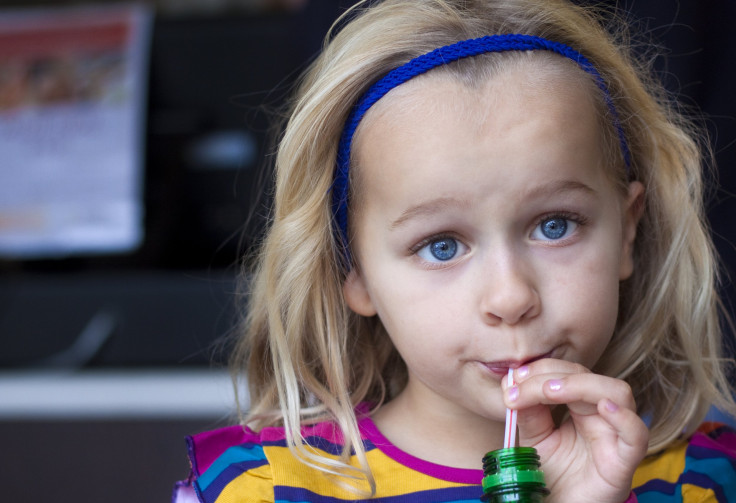Soda Or Energy Drinks: Which Is Worse For Kids' Health?

Between the bright colors, cartoons, commercials, and accessibility, energy drinks and sodas are a health hazard for children. Energy drinks are popular among teenagers and college kids, and if they have a little sibling watching them guzzle down these sugary, caffeinated drinks, they may want one, too. Consuming too much caffeine can cause adverse health effects, however, and a child’s little body is much more susceptible to the dangers of energy concoctions.
Add some more sugar and less caffeine, and you have a different danger to children: soda. Sugar-sweetened beverages are one of the major bad guys in America’s health problem, and kids are increasingly grabbing cans with eager hands. But is caffeine overload worse than sugar?
Energy Drinks And Kids
Recently, the American Heart Association (AHA) found out of the 5,000 cases of sickness reported to poison control about energy drinks, 40 percent involved kids 6 years old and younger. Not only were they children, but it was also an accident. Many of the cases involved serious side effects, including seizures, irregular heart rhythms, or dangerously high blood pressure. They didn’t go to the store to buy the drinks themselves, but instead found it in the fridge or left out by a parent. What child wouldn’t be attracted to the bright and colorful cans and bottles of energy drinks?
“Energy drinks have no place in pediatric diets,” the study’s lead author Steven Lipshultz, the chief pediatrician at Children’s Hospital of Michigan in Detroit, said in a press release. “And anyone with underlying cardiac, neurologic, or other significant medical conditions should check with their health care provider to make sure it’s safe to consume energy drinks.”
These bottle rockets of fuel are completely unnecessary for children, who are naturally energetic. In addition to all the extra caffeine, energy drinks also contain many other mysterious additives that could pose a threat to their little beating hearts. Extracts such as guarana, bitter orange, and other tossed in waker-uppers are unpredictable because they weren’t designed for children to consume in the first place. There are no studies that involve children other than examination of accidental exposure, such as the ones found by the AHA.
"You can't really dissect out what is the effect of ginseng, what is the effect of taurine, what is the effect of guarana, what is the effect of caffeine," Lipshultz told Live Science. "If you ask most people, they'd say teenagers and young adults drink it, but children may be more susceptible."
By labeling energy drinks with a warning similar to that of the Surgeon General’s cigarette and alcohol ones, maybe the rate of incidents would fall, Lipshultz added.
"People have to understand how caffeine can affect your body," senior scientist from NSF International John Travis told Medical Daily. "When they get jittery, they need to see their doctor and make sure they’re not at risk for anything. Medications, alcohol, and even exercise can change the way the body handles energy drinks because it’s a diuretic."
Travis agreed caffeine acts as a drug in the body and should be treated as one. He tests the caffeine levels and double checks to make sure there aren’t any unknown ingredients in the drink. Energy drink giant Red Bull passed the NSF approval, and consumers can rest assured by checking for the label on the can.
"The reported data probably represent the tip of the iceberg," Lipshultz said. Between sugar and caffeine, there’s no doubt there’s harm. But energy drinks pose more of a threat with their dauntingly high levels of caffeine that even some adults can't handle.
Liquid Candy And Kids
Caffeine levels in soda are much lower than energy drinks, which makes them the lesser of two evils. Children shouldn’t be drinking soda to begin with because they don’t need any more sugar than they’re already exposed to. A 12-ounce can of Coca-Cola, for example, contains 23 to 35 milligrams of caffeine, according to Mayo Clinic. When looking at soda’s harm for children, it’s more important to highlight the dangers of all that sugar. Sugary beverages are loaded with empty calories that can lead to type 2 diabetes.
Currently, the United States is experiencing a childhood obesity epidemic. The amount of obese children has tripled from just one generation ago, according to the Centers for Disease Control and Prevention. Adolescents that drank more than five cans of soda every week were more likely to be violent to their friends and family, according to a study published in Injury Prevention. They’ve also tended to eat less vegetables and then grow up to be more emotionally distraught and depressed teenagers.
Or maybe it’s all of that high fructose corn syrup that doesn’t process through the body well because it leads to fat deposits in the liver and plaque buildup. There’s just something about the spikes and plummets of the sugar cycle that don’t mesh well with kids.



























